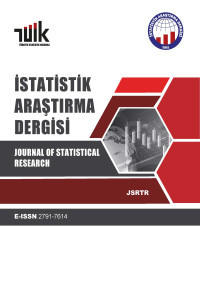Veri Zarflama Analizinde Ağırlık Kısıtlarının Belirlenmesinde K-En Yakın Komşuluğa Dayalı Bir Yaklaşım
Genellikle etkinlik ölçümünde kullanılan Veri Zarflama Analizi (VZA), popüler bir yönetim aracı olmaya başlamıştır. Klasik etkinlik yaklaşımlarının tersine, VZA’nın en önemli avantajı, girdi ve çıktı değişkenlerinin ağırlık kısıtlarını araştırmacıların belirleyebilmesidir. Değişken seçimi ve ağırlık kısıtlarının belirlenmesi VZA’da önemli konulardır. Bu çalışma VZA için ağırlık kısıtlarının tanımlanmasında K-en yakın komşuluk algoritmasının kullanımını araştırmaktadır. Bu amaçla K-en yakın komşuluk temeline dayanan yeni bir yaklaşım önerilmiştir. Belirlenen kısıtlara bağlı olarak ampirik ve gerçek veri setleri ile uygulamalar yapılmıştır. K-en yakın komşu temelinde kısıtlı model ve ağılık kısıtlamasız VZA modeli için performans skorları hesaplanmıştır ve sonuçlar yorumlanmıştır.
Anahtar Kelimeler:
Ağırlık kısıtları, Etkinlik, Veri zarflama analizi, K-en yakın komşuluk
A K-Nearest Neighbor Based Approach for Determining the Weight Restrictions in Data Envelopment Analysis
Data Envelopment Analysis (DEA), a method commonly used to measure the efficiency is becoming an increasingly popular management tool. On the contrary to classical efficiency approaches, the most important advantage of DEA is that researchers can determine the weight restrictions of input and output variables. Variable selection and determination of weight restrictions are important issues in DEA. This work investigates the use of K-nearest neighbor (KNN) algorithm in the definition of weight restrictions for DEA. With this purpose a new approach based on KNN is proposed. Applications are constructed with empirical and real data sets depending on the specific constraints. Performance scores were calculated for both KNN based restricted and unrestricted DEA models and the results are interpreted.
___
- Allen R., Athanassopoulos A., Dyson R. G., Thanassoulis, E., 1997. Weights Restrictions and Value Judgements in Data Envelopment Analysis: Evolution, Development and Future Directions, Annals of Operations Research, 73:13 – 34.
- Allen R., Thanassoulis E., 2004. Improving Envelopment in Data Envelopment Analysis, European Journal of Operational Research, 154, 363–79.
- Beasley J. E., 1990. Comparing University Departments, Omega, International Journal of Management Science 18:171 - 183.
- Charnes A., Cooper W. W., Rhodes E., 1978. Measuring the Efficiency of Decision Making Units, European Journal of Operational Research, Vol.2 No: 6, 429-444.
- Charnes A., Cooper W. W., Rhodes E., 1979. Short Communication: Measuring the Efficiency of Decision Making Units, European Journal of Operational Research, 3, 339.
- Charnes A., Cooper W. W., Golany B., Seiford, L., 1985. Foundations of Data Envelopment Analysis for Pareto-Koopmans Efficient Empirical Production Functions, Journal of Econometrics, 30, 91–108.
- Charnes A., Cooper W. W., Lewin A. Y., Seiford L. M. (Eds.)., 1994. Data Envelopment Analysis: Theory, Methodology, and Applications, Boston: Kluwer.
- Cooper W. W., Thompson R. G., Thrall R. M., 1996. Introduction: Extensions and New Developments in Data Envelopment Analysis, Annals of Operations Research 66(1):1-45.
- Cooper, W. W., Seiford, L. M., Tone, K., 2000. Data Envelopment Analysis, Kluwer Academic Publishers, Boston, USA.
- Farrell M. J., 1957. The Measurement of Productive Efficiency, Journal of the Royal Statistical Society, Series A, 120:253–81.
- Dimitrov S., Sutton W., 2010. Promoting symmetric weight selection in data envelopment analysis: A penalty function approach, European Journal of Operational Research, 200, 281-288.
- Felici G., Vercellis C., 2008. Mathematical Methods for Knowledge Discovery and Data Mining, Information Science Reference, Hershey, New York.
- Golany B., 1988. A Note on Including Ordinal Relation among Multipliers in DEA, Management Science, 34, 1029–33.
- Gonçalves A. C., Almeida R. M. R. V., Lins M. P. E., Samanez C. P., 2013. Canonical Correlation Analysis in the Definition of Weight Restrictions for Data Envelopment Analysis.
- Hand D. J., Mannila H., Smyth P., 2001. Principles of Data Mining, MIT Press.
- Jahanshahloo G. R., Memariani A., Hosseinzadeh F., Shoja N., 2005. A feasible interval for weights in data envelopment analysis, Applied Mathematics and Computation, 160, 155–168.
- Kocakoç İ. D., 2003. Veri Zarflama Analizi’ndeki Ağırlık Kısıtlamalarının Belirlenmesinde Analitik Hiyerarşi Sürecinin Kullanımı, D.E.Ü.İ.İ.B.F.Dergisi 18(2):1-12.
- Mecit E. D., Alp İ., 2012. A New Restricted Model Using Correlation Coefficients as an Alternative to Cross-Efficiency Evaluation in Data Envelopment Analysis, Hacettepe Journal of Mathematics and Statistics, 41(2), 321-335.
- Podinovski V. V., Athanassopoulos A. D., 1998. Assessing the Relative Efficiency of Decision Making Units using DEA Models with Weight Restrictions, The Journal of the Operational Research Society, 49, 500–08.
- Podinovski V. V., 1999. Side Effects of Absolute Weight Bounds in DEA Models, European Journal of Operational Research, 115, 583–95.
- Podinovski V. V., 2001. DEA Models for the Explicit Maximisation of Relative Efficiency, European Journal of Operational Research, 131, 572–86.
- Podinovski V. V., 2004. Production Trade-offs and Weight Restrictions in Data Envelopment Analysis, The Journal of the Operational Research Society, 55,1311–22
- Roll Y., Cook W. D., Golany B., 1991. Controlling Factor Weights in Data Envelopment Analysis, IIE Transactions, 23:1, 2-9.
- Sarrico C. S., Dyson R. G., 2004. Restricting Virtural Weights in Data Envelopment Analysis, European Journal of Operational Research, 159, 17–34.
- Thanassoulis E., Boussofiane A., Dyson R. G., 1995. Exploring Output Quality Targets in the Provision of Perinatal Care in England using Data Envelopment Analysis, European Journal of Operational Research, 80, 588.
- Thompson R. G., Singleton, F. D., Thrall R. M., Smith B. A., 1986, Comparative site evaluations for locating a high-energy physics lab in Texas, Interfaces 16:35-49.
- Thompson R. G., Langemeier L. N., Lee C. T., Lee E., Thrall R. M., 1990. The Role of Multiplier Bounds in Efficiency Analysis with Application to Kansas Farming, Journal of Econometrics, 46, 93–108.
- Talaue C. O., Diesta N. A. N., Tapia C. G., 2011. Weights Restriction by Multiple Decision Makers in Data Envelopment Analysis Using Fuzzy Programming, Proceedings of the 11th Philippine Computing Science Congress, Ateneo de Naga University.
- Ye N., 2003. The Handbook of Data Mining, Lawrence Erlbaum Associates, Publishers Mahwah, New Jersey, London.
- Zhu J., 2003. Imprecise Data Envelopment Analysis (IDEA): A Review and Improvement with an Application, European Journal of Operational Research, 144, 513–29.
- ISSN: 1303-6319
- Başlangıç: 2002
- Yayıncı: TÜİK
